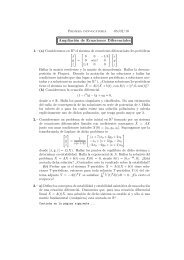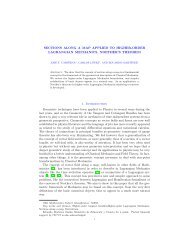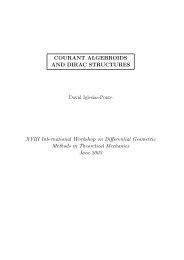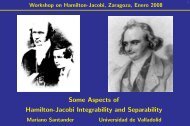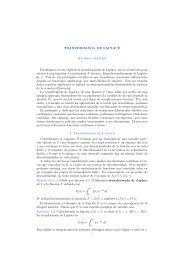PARALLEL TRANSPORT AND DECOUPLING 1. Introduction One of ...
PARALLEL TRANSPORT AND DECOUPLING 1. Introduction One of ...
PARALLEL TRANSPORT AND DECOUPLING 1. Introduction One of ...
You also want an ePaper? Increase the reach of your titles
YUMPU automatically turns print PDFs into web optimized ePapers that Google loves.
2 EDUARDO MARTÍNEZdecoupled by a coordinate change and finally in section 7 the case <strong>of</strong> a completedecoupling into scalar second-order differential equations is analyzed.2. PreliminariesLet π : E → R be a fibre bundle with fibre dimension n, and let π 1 : J 1 π → Rbe its first jet bundle. The vertical bundle with respect to the bundle projectionπ is denoted by Ver(π), whereas the vertical bundle with respect to the projectionπ 10 : J 1 π → E will be denoted by Ver(π 10 ), i.e. Ver(π) = Ker(T π) and Ver(π 10 ) =Ker(T π 10 ).We consider the canonical coordinate t on R and natural bundle coordinates(t, x i ) on E and (t, x i , v i ) on J 1 π. Any time-preserving coordinate transformation(t, x i ) → (t, ¯x i ), where ¯x i = ¯x i (t, x) leads to the following formulas for thecoordinate transformation on J 1 π,t = t, ¯x i = ¯x i (t, x), ¯v i = ∂¯xi∂t + ∂¯xi∂x j vj ,from where we can clearly see the affine character <strong>of</strong> the bundle J 1 π, whoseassociated vector bundle is Ver(π). The fibre over an element m ∈ E can beconsidered as an affine hyperplane <strong>of</strong> the tangent space at m, and therefore wehave the following sequence <strong>of</strong> vector spaces 0 → Ver(π) m → T m E → R → 0, wherethe map in the right consists in taking the t-component v ↦→ 〈dt, v〉. Elements <strong>of</strong>J 1 π can be identified with tangent vectors to E which projects onto ∂/∂t. Thisidentification may be regarded as defining a map T : J 1 π → T E, given by T (jt 1 γ) =˙γ(t). We therefore have the following commutative diagram <strong>of</strong> vector bundles overE, where the row is an exact sequence,0 Ver(π)i T Ej E × R 0.T(π 10,1) J 1 πA section <strong>of</strong> π ∗ 10(T E) is said to be a vectorfield along π 10 . Alternatively, it canbe considered as a map X : J 1 π → T E such that τ E ◦X = π 10 , that is X(p) ∈ T m Efor every p ∈ (J 1 π) m . The section associated to this map is just p ↦→ (p, X(p)).For instance, the map T above can be considered in a natural way as a vector fieldalong π 10 , called the total time derivative, and which in coordinates readsT = ∂ ∂t + ∂vi∂x i .Any vectorfield Y on E gives rise to a vectorfield along π 10 by composition withthe projection π 10 . Explicitly the associated section <strong>of</strong> the pullback bundle is p ↦→(p, Y (m)) where m = π 10 (p). The vectorfields along π 10 which arise in this way arecalled basic.A sode on E is a vectorfield Γ ∈ X(J 1 π) which projects onto T . In coordinatesit is <strong>of</strong> the formΓ = ∂ ∂t + ∂vi∂x i + f i ∂∂v iwhere f i = f i (t, x j , v j ). Therefore the system <strong>of</strong> differential equations for the integralcurves <strong>of</strong> Γ is the non-autonomous second-order system <strong>of</strong> differential equations,





